Urwerk UR-100V Time And Culture: 27-Ton Aztec Sun Stone Miniaturized For The Wrist
The year is 1502 and you are a stonemason living in central Mexico under the rule of the newly crowned Tlatoani (leader), Moctezuma Xocoyotzin. Your new emperor has called for the creation of a massive ritual stone table that is going to take you and another mason years to complete. The request is a boon to your family, which will be blessed under this new reign as wealth and prosperity come to all in the city-state of Tenochtitlan.
But little do you know that right then, 2000 miles toward the rising sun is a race of men that will soon leave everything you know and love in ashes. The Spanish are just a couple of decades away from invading Mexico, and with the help of enemies of your people they will brutally conquer your city and bury this stone table to hide the traces of your culture. You aren’t even aware that you are at the end of the Mesoamerican Postclassic Period that will define the last days of a distinctive culture.
In that ignorance you set to work, slowly tracing and carving the intricate details of the symbols and animals crucial to the various ceremonies. Day after day you slowly shape the stone into something that will last beyond the end of the empire, though you are unaware of this fact. You are surrounded by objects that sing the glories of your ancestors, yet you will have no ancestors that continue in your ways of life. You are the last generation to live this culture; time will march on and you will be known only by your work.
This is the story similar to that of thousands, possibly millions, of talented artisans across the history of our species. More cultures and civilizations than we currently know have been lost to the sands of time, whether through famine, disease, disaster, or hostile destruction – cultures faded from our memories, never to be heard from again.
Impressively, every one of these cultures had its own complex relationship with time, its measurement, and its representation. From calendars to creation stories, every culture understood time differently and developed unique ways of thinking about it.
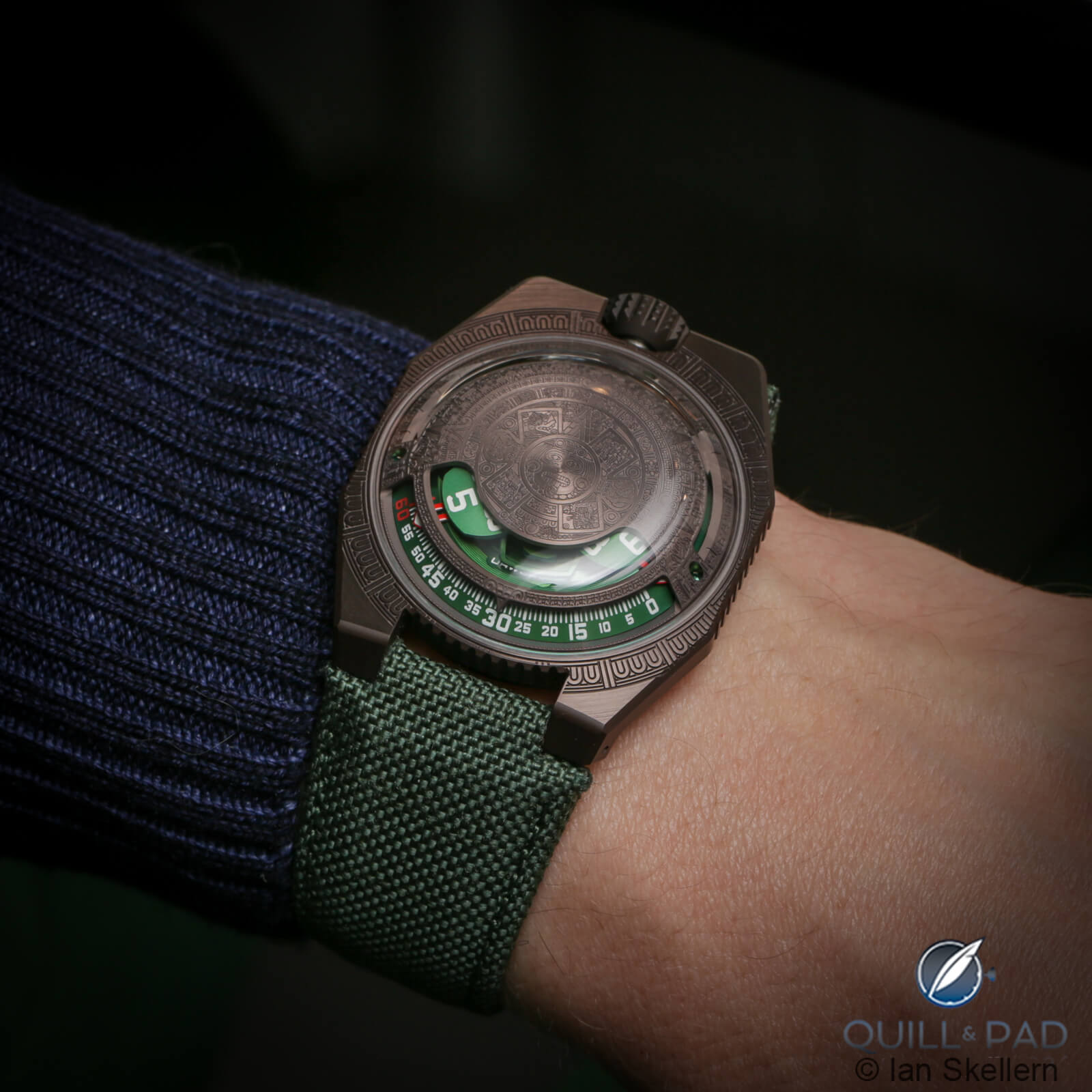
Urwerk UR-100V Time and Culture on the wrist
That fact inspired Urwerk to develop a design series to honor the historical cultures that have related to time. The first of which is the UR-100V Time and Culture. This timepiece focuses on the Aztec sun stone, highlighting the complex relationship between the Aztecs, the seasons, and their place in time
Urwerk UR-100V Time and Culture
This horological experiment in design and culture is based on the popular UR-100 SpaceTime, which first debuted at the end of 2019. The core of the UR-100 is the satellite hour display that travels along a 120-degree arc, tracing the minutes from right to left before another pointer emerges at zero. The pointer from the previous hour continues around the perimeter to display astronomical indications in a pair of small windows on each side of the case.

Urwerk UR-100V Time and Culture
The case was a fairly tame creation for Urwerk at the time, which made sense as the UR-100 was the most accessible piece from the brand to date. But the new UR-100V Time & Culture adds a whole new perspective to the piece.
This is where we come to the Aztecs, the sun stone, and a man from Singapore. The idea originated from a conversation with Su Jia Xian, better known as SJX, a watch journalist and collector from Singapore. In a conversation, SJX described the UR-100 combined with the cover of the original UR-103 or even the openable cover of the UR-105 with intricate engraving across its surface, perhaps something akin to the Mayan calendar. The result of further conversations and creative brainstorming between Urwerk co-founders Felix Baumgartner and Martin Frei was the absolutely stunning UR-100V Time and Culture.
The domed plate covering most of the hour carriage is entirely engraved with a copy of the iconic Aztec sun stone, a ceremonial stone slab depicting a variety of animals, elements from nature, and important aspects of Aztec life. The case is made of steel with an aged copper finish, something I would argue looks more like a black oil-rubbed bronze with its dark warmth.

Urwerk UR-100V Time and Culture
The finish is well chosen for the UR-100V Time and Culture, making it feel appropriately ancient while still clearly being a science-fiction watch. In the window just after the 60-minute display, the tip of the hour hand tracks physical distance that the earth travels. In this case it is the distance covered by a person in Mexico City every 20 minutes as the world rotates, approximately 524.89 kilometers. It’s a very human-centered scale, although it displays something nearly no one would be aware of since it took thousands of years to even realize we live on a sphere rotating 360 degrees a day.
Speaking of that sphere, the second window is an astronomically centered scale tracking the distance the earth orbits around the sun every 20 minutes, approximately 35,742 kilometers (it orbits at a speed of roughly 29.8 km/s). This combines both the terrestrial concerns of the Aztecs with the celestial aspirations they had as they charted the night sky with incredible accuracy.
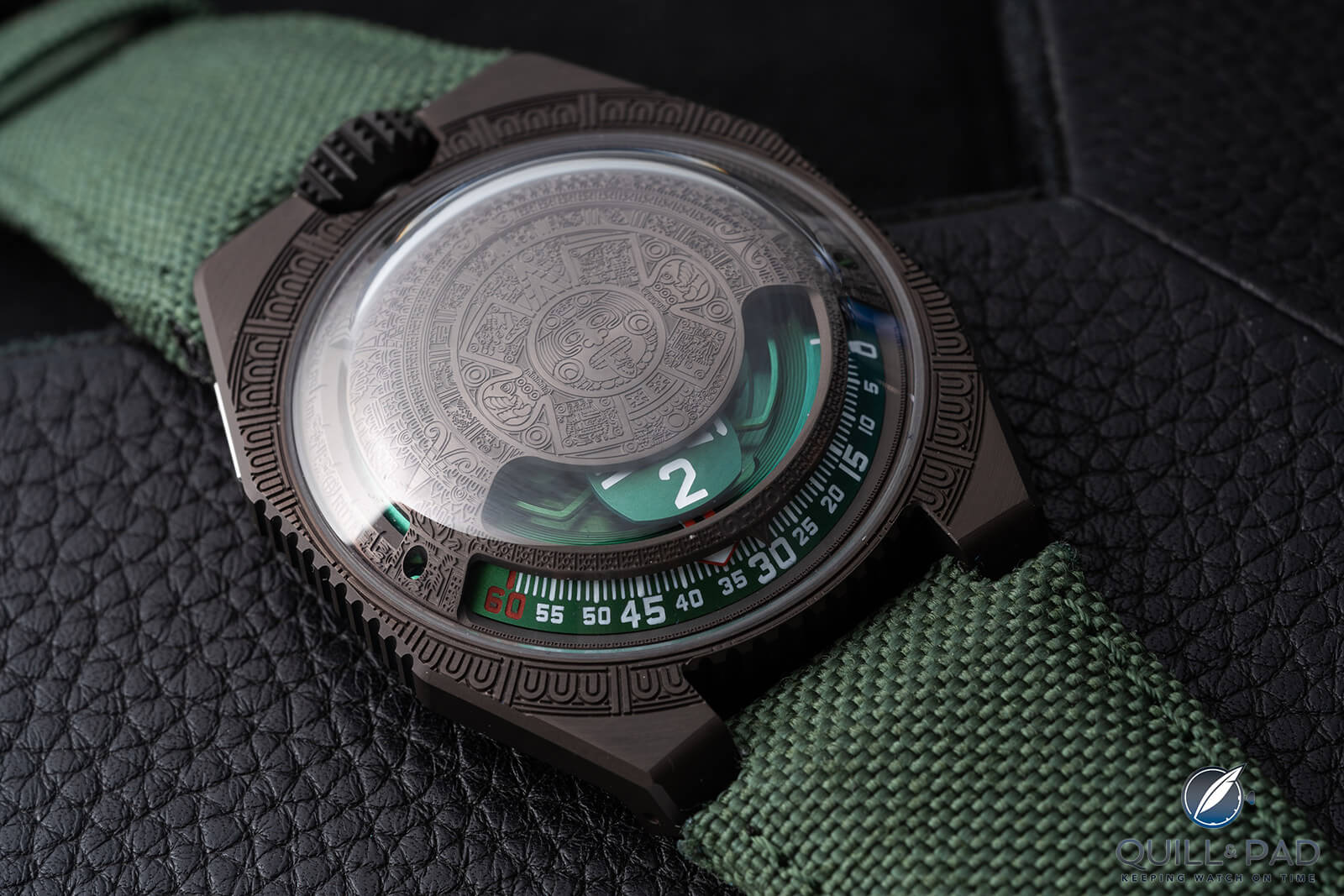
Urwerk UR-100V Time and Culture (photo courtesy Alex Teuscher)
The universe and time
Both time and the universe are at the center of the 100V collection, a line dedicated to “perceptions of time through the ages and cultures,” as Urwerk explains, exploring the many ways that humanity has related to and tracked time throughout history. The Aztec sun stone had a variety of uses but one related to the Aztec calendar: the inner ring refers to the 20 days of the 18 months in the Aztec solar calendar. The glyphs represent different cyclical concepts of time and their relationships with cosmic conflicts in Aztec ideology.
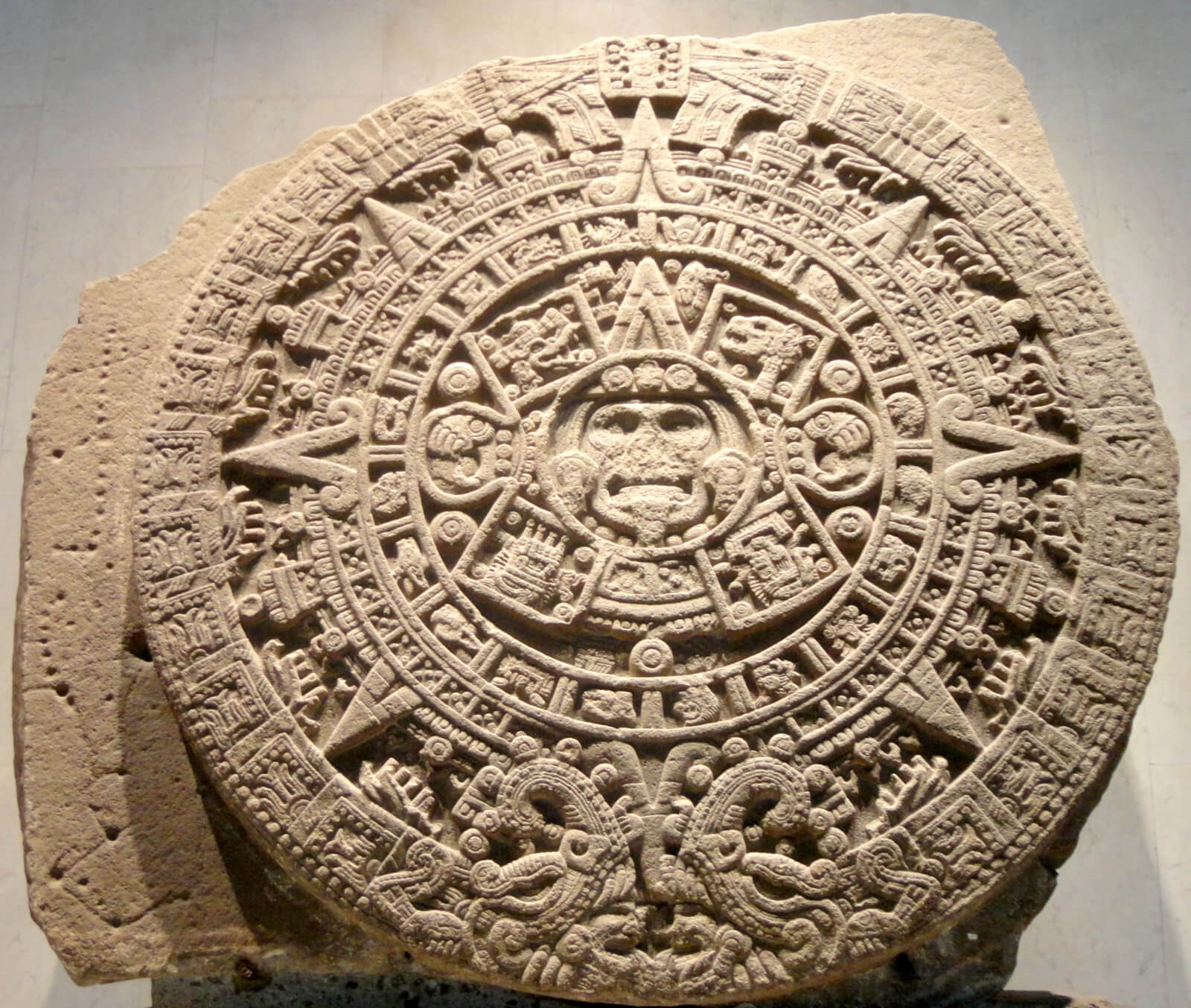
The Aztec sun stone (photo courtesy Juan Carlos Fonseca Mata/Wikipedia)
The stone also gives an insight into how the Aztecs divided their time: the solar calendar was based on a 360-day cycle with five intercalary (unnamed) days inserted between the years that were thought to be bad luck, giving the Aztecs a functional 365-day year. The Aztecs also had a 260-day cycle related to their 20-day month corresponding to 13 days, which would give days names such as One Crocodile or Four Vulture. This imbalanced relationship led to the 260-day count, which is how long it would take for it to realign, making One once again a crocodile.
That is how the Aztecs understood their century as well: an Aztec century was 52 years, which was the number 13 multiplied by four main deities and cardinal directions: Tochtli (rabbit/south), Acatl (reed/east), Tecpatl (flint/north), and Calli (house/west). This corresponded to a specific relationship within the 260-day count. As 260 days does not evenly divide into 365, the first day of the year and the first day of the day count became misaligned after the first year.
It takes exactly 73 cycles of 260 days for the first day of the year and the first day of the day count, One Crocodile, to realign. If you multiply 52 years by 365 days the result is 18,980 days, which divided by the 260-day count equals 73.
All of this information is effectively carved into the Aztec sun stone and now into the face of the UR-100V Time and Culture.

Back of the Urwerk UR-100V Time and Culture
Intricate detailing
The original sun stone is a massive 358 centimeters (nearly 12 feet) across, 98 centimeters (3.25 feet) thick, and weighs in at a whopping 27 tons, which gave the stone masons plenty of room to carve all the intricate details.
Urwerk had less than 41 millimeters, or 1/1000 of the available space. This meant the design required an engraving bit with a tip of only .05 mm, and the design is incredibly fine. The recesses were finished via abrasive blasting for a nice matte finish while the surfaces are satin brushed to provide a bit of a glow to the engraving.
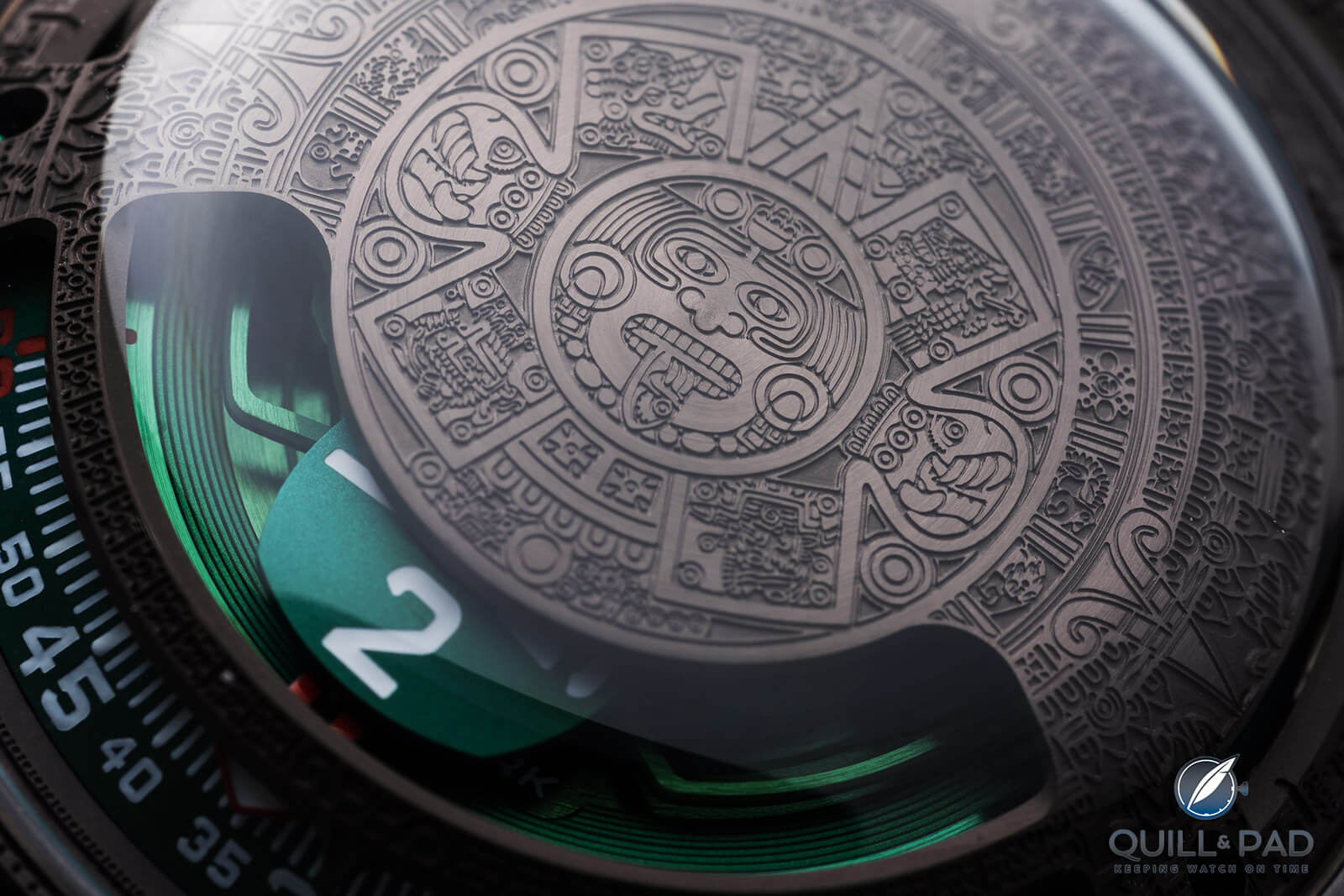
Urwerk UR-100V Time and Culture (photo courtesy Alex Teuscher)
The minute track, hour carrousel, and underlying plates have all been finished with a glittering emerald green color, which also extends to the strap, a woven green Baltimora fabric that adds another layer of flair to the UR-100V Time and Culture. The domed cover over the wandering hours rests below the sapphire crystal, protecting the delicate engraving. But the design extends onto the case with a motif surrounding the crystal as a quasi-bezel, tying the entire presentation together.
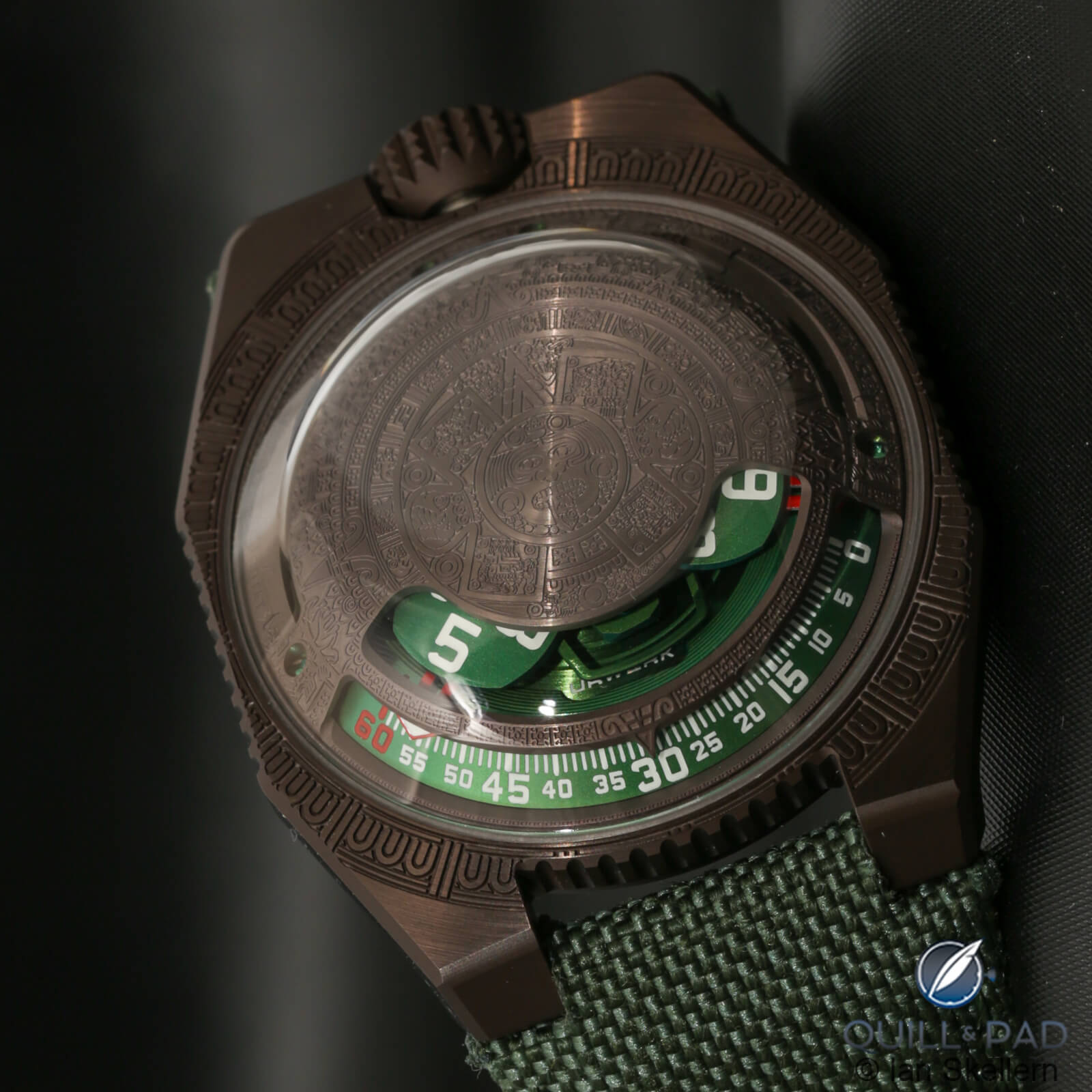
Urwerk UR-100V Time and Culture
A few mysterious details are also at play: the initials of SJX are found micro-engraved into the sun stone design and a Mayan numbering system is there to be deciphered. Finally, on the side of the case is a plaque with a mysterious pair of symbols that aren’t described by Urwerk, so they remain to be discovered and understood by the observer.
History is like that, without every answer given to you, and that is the wonder of discovering how different cultures related to space and time. The sun stone is an artifact that provides a glimpse into Aztec culture, but it hides just as much as it exposes. We will never fully understand that culture and the importance of how time played into the lives of its people, just like people of the future may not grasp our own relationship with weekends, holidays, or how we celebrate the new year.
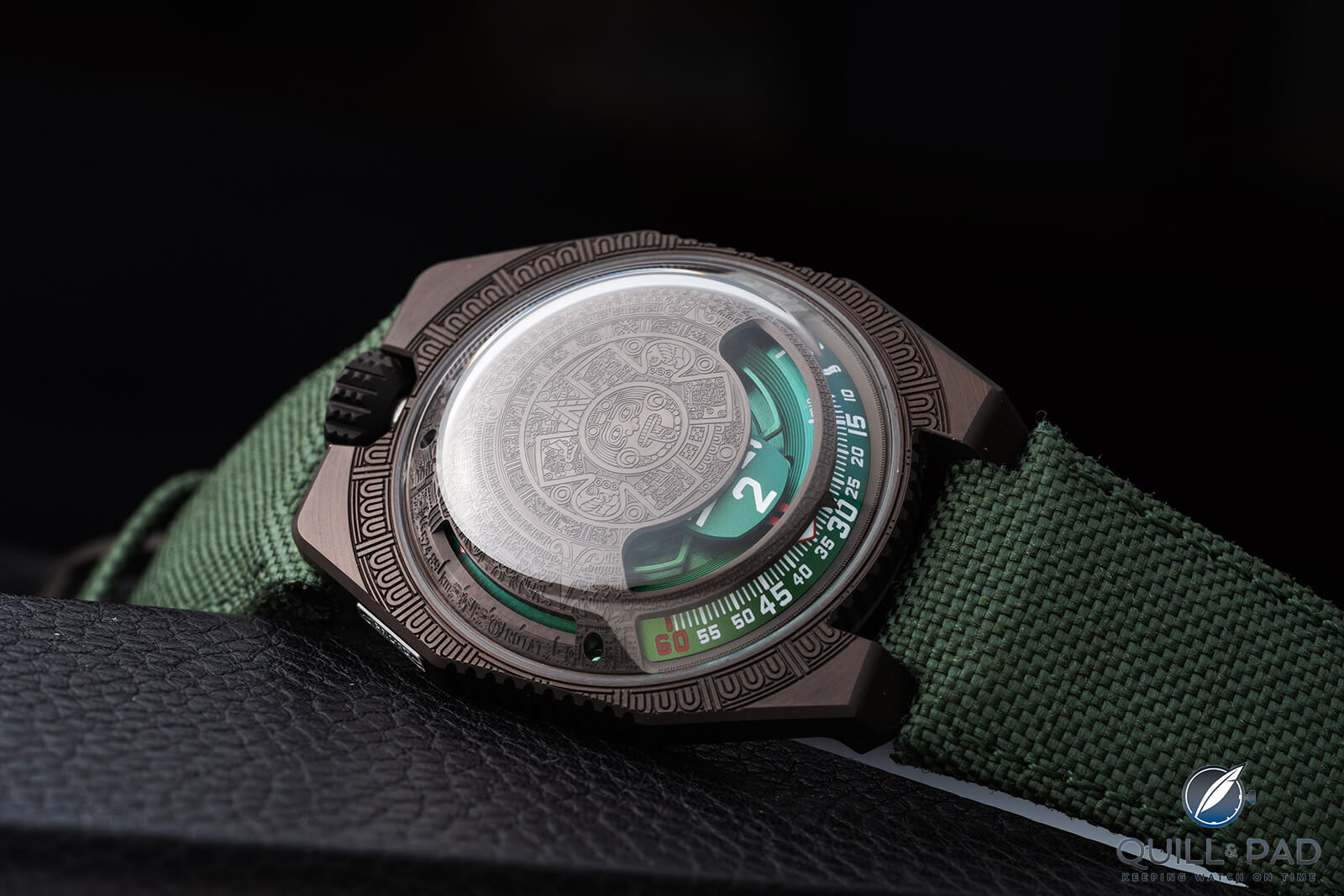
Urwerk UR-100V Time and Culture (photo courtesy Alex Teuscher)
The UR-100V Time and Culture is the first entry into a new concept exploring humanity’s relationship with time and space, and there’s no one better to begin this journey than Urwerk. Nor where better to start than with the fascinating Mesoamerican culture of the Aztecs.
The concept is unique among watch brands, and I can guarantee you that with Frei and Baumgartner at the helm, the next editions will be just as extraordinary and intriguing!
Until then, let’s try and break down this timepiece inspired by a more than 500-year-old relic!
- Wowza Factor * 9.4 The sun stone details engraved into steel underneath the domed sapphire crystal is enough to make anyone go wow, especially a stone carver from the fifteenth century!
- Late Night Lust Appeal * 94» 921.825m/s2 To understand time and our relationship to the cosmos enough to build an accurate depiction of the months requires many late nights staring at the sky. Now you can spend that time lusting after this watch!
- M.G.R. * 67.9 Anything from Urwerk will be geeky enough to get my watch love going, and the UR12.02 is no exception!
- Added-Functionitis * Mild This is a watch that makes one time display into three functions just by understanding how time relates to space (literally!). For that reason you should take some children’s strength Gotta-HAVE-That cream and keep on enjoying this lesson in history and awesome watches!
- Ouch Outline * 10.4 An accidental cut with a razor! No matter how careful you are, the safe and ubiquitous personal razor we all use to shave our faces, armpits, or legs can cut you very badly if you slip in just the wrong way. And it is so sharp that the main result will be lots of blood. So be careful. I know I will, but if it takes a bad cut to get this bad boy on my wrist, I’ll take that chance!
- Mermaid Moment * That engraving calls to me! The incredible detail found in the engraving of the sun stone on the 100V Time and Culture is more than enough to have me looking at china patterns and centerpieces!
- Awesome Total * 721.2 Start with number of pieces in the limited edition (20), multiply by the caliber number (12.02), and multiply again by the number of separate indications (3) for an out-of-this-world awesome total of time and space!
For more information, please visit www.urwerk.com/collections/ur-satellite/ur-100.
Quick Facts Urwerk UR-100V Time And Culture
Case: 41 x 49.7 x 14 mm, steel and titanium
Movement: automatic Caliber UR12.02, 48-hour power reserve, 28,800 vph/4 Hz frequency with Windfänger winding regulator system
Functions: satellite hours, minutes; distance traveled by Mexico City in 20 minutes, revolution of the earth around the sun in 20 minutes
Limitation: 20 pieces
Price: CHF 68,000
You may also enjoy:
Urwerk UR-100V P.02 For Collective: Collaboration And Exclusivity Dock In Space
Back To The Future: The Urwerk UR-105M
Urwerk And The Gustave Sandoz Clock That Doesn’t Tell The Time
Leave a Reply
Want to join the discussion?Feel free to contribute!



I love this design with a caveat. I’m not usually one to flag cultural appropriation, but having just read a culinary history of Mexico, I’m reflecting on the destruction of the Aztecs, they were no angels BTW, and persecution, suppression of indigenous cultures by the Spanish. Now we have a $70K swiss watch..HMMM.
As you say there is a terrible history of persecution, abuse, and destruction from the Spanish colonizers, though the Swiss didn’t have much to do with colonial expansion until later investments in the 18th and 19th centuries, and never were directly colonizers themselves. The Swiss definitely have a lot of blood on their hands thanks to their support of the slave trade and the eventual safe haven for stolen Jewish capital and ill-gotten gains from countries throughout the world. But that is all separated from a small company seeking to commemorate and honor the culture and intelligence of the Aztecs by showcasing Aztec art.
The idea of cultural appropriation is always a dicey topic because people belonging to the appropriated group can have completely opposite opinions on what is appropriation and what is not. If the Catholic church specifically started to display Aztec iconography as part of the church’s influence around the world – THAT would be appropriation largely because the Catholic church was the main influencing authority that suppressed and outlawed Aztec and ethnic Mexican cultural and spiritual practices after colonization.
It is hard to argue that a pair of watchmakers that shine a spotlight on the ingenuity and astronomical knowledge of a culture, while making sure to reference the history as accurately as possible, are appropriating their culture to sell a watch.